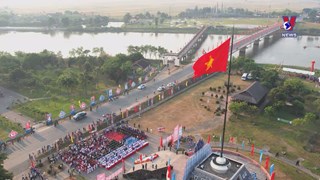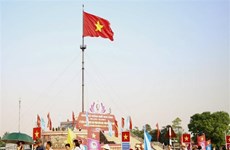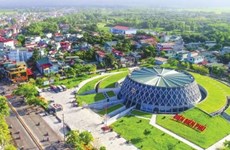Impressive 700-year-old wooden bridge roofed with leaves
Lang Kenh bridge, measuring 10 meters in length, 4 meters in width and 3 meters in height, boasts all of its posts, beams, pillars, and floor made of ironwood, and a roof of boi (Corypha umbraculifera) leaves. Inside the bridge are two lines of wooden benches on which commuters can rest.
 Lang Kenh bridge spanning Hai Ninh river. (Photo: VietnamPlus)
Lang Kenh bridge spanning Hai Ninh river. (Photo: VietnamPlus)The unique bridge is located in Kenh village, Co Le township, Truc Ninh district, Nam Dinh province. It was built about 700 years ago, in the Ly dynasty, after the royal court had a canal dug to take water from the Red river. The bridge, spanning the two banks of Hai Ninh river, serves as the only way to Co Le pagoda taken by pilgrims in the old days. After 700 years, the bridge now still maintains its unique and antique architecture.
Lang Kenh roofed bridge spanning Hai Ninh river. (Photo: VietnamPlus)
"Residence upper, bridge lower” is a popular architecture in Asian tropical countries. The term is used for roofed wooden bridges, a very humane structure for both travel and rest.
The architecture came into being in Vietnam from the middle of the 15th century when Japanese came and built the Chua Cau (Pagoda Bridge) in Hoi An. There are now only a handful of bridges in this architecture in Vietnam, most of them recognised as Culture Heritages.
Nam Dinh province takes pride of the three such bridges, namely Hai Anh in Hai Hau district, Cho Thuong in Nam Truc district, and Lang Kenh. Of those, Lang Kenh is the only in Vietnam to be roofed with leaves.
 The only leave-roofed in Vietnam. (Photo: VietnamPlus)
The only leave-roofed in Vietnam. (Photo: VietnamPlus)All in all, the bridge was supported with 28 pillars, including the four main supports measuring more than 50 cm in diameter. They have been worn out by the time and replaced with new wooden ones.
Lang Kenh bridge has five spans, each measuring from 1.45-1.65m. It is 10 meters long, 4 meters wide, and 3 meters high. All of its pillars, beams and floor are made of ironwood, with the floor made of thick planks measuring more than 40 cm in width.
Inside the bridge are two lines of wooden benches running along it, serving as a place to rest for commuters. Villagers often take a rest or enjoy some fishing at the bridge in hot summer days or in their leisure time.
 Wooden benches along the bridge serve as a place to rest for commuters. (Photo: VietnamPlus)
Wooden benches along the bridge serve as a place to rest for commuters. (Photo: VietnamPlus)Tiles were not used to roof the bridge. Instead, boi leaves were the choice thanks to its local availability and light weight that could sustain winds and storms. Locals said after repeated renovations, the bridge’s roof has been made from palm leaves.
In the old times, the bridge was in the North-South direction but after an adjustment of the canal system, it has been changed into the East-West one to suit the travel demand of locals.
 The bridge railing is rustically carved. (Photo: VietnamPlus)
The bridge railing is rustically carved. (Photo: VietnamPlus) The lines recording the date of the construction of Lang Kenh roofed bridge. (Photo: VietnamPlus).
The lines recording the date of the construction of Lang Kenh roofed bridge. (Photo: VietnamPlus).












